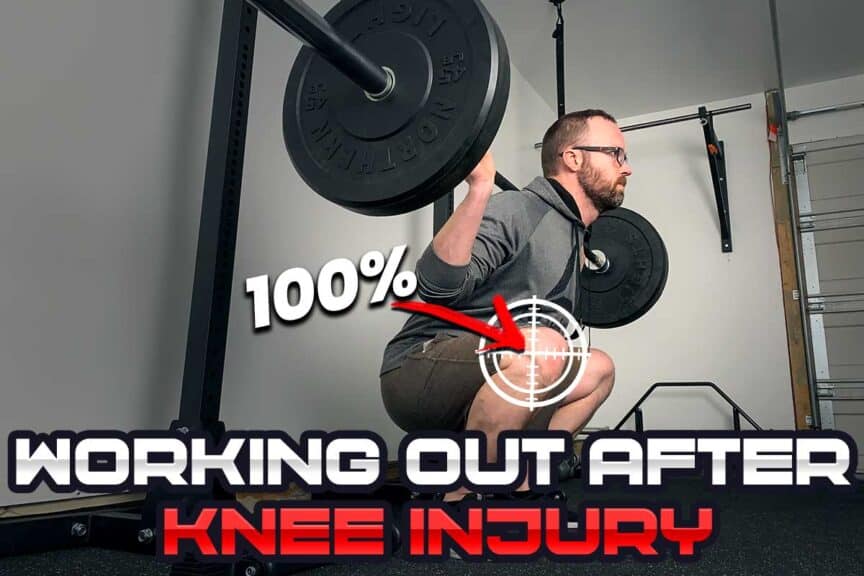If you’re looking to lift weights and workout again after any type of knee issue, you have my genuine admiration; committing yourself to get back on track following an injury can feel daunting at the best of times. That’s why I’ve written this article, which will walk you through the necessary steps to implement to keep you confident throughout the process as you work to rebuild the health of your knee.
Lifting weights after knee injury involves understanding your injury and tissue healing timelines, using optimal loading strategies, incorporating multi-directional movements, and slowly progressing your range of motion and speed of movement. This helps ensure optimal recovery for your knee.
As a physical therapist and a strength and conditioning specialist, I can assure you that these are incredibly effective steps that lead to optimal knee recovery when adhered to and performed correctly. And the best part is that these steps often involve lifting weights and working out.
So, in this article, I’ll discuss how to go about this entire process.
It’s time for a comeback!

Related content:
As we dive into the article, keep in mind that the following strategies below aren’t necessarily in order; it may help to follow them in the sequence in which they’re listed, but they can often be incorporated simultaneously or, at times, in a different order.
That being said, if you’re not confident with strengthening your knee on your own, your best bet is to get direction and guidance from a qualified healthcare professional, such as an orthopedic physical therapist.
A small request: If you find this article to be helpful, or you appreciate any of the content on my site, please consider sharing it on social media and with your friends to help spread the word—it’s truly appreciated!
Strategy 1: Understand your injury
When it comes to the specifics I’m about to go through, it’s imperative to know that the extent and type of your initial knee injury will determine where and how you need to start off when lifting weights after an injury.
However, regardless of these specifics, your path to lifting weights while strengthening your knee (and keeping it safe) needs to start with a basic understanding of your injury.
This basic understanding is essential as it will help you better understand the following:
- Why specific stages of rehabilitation are implemented and why your return to lifting weights must be progressed accordingly.
- Why specific weightlifting movements and activities should temporarily be avoided while others are encouraged.
- What should be considered normal and abnormal for knee pain and discomfort when lifting weights and exercising.
This basic understanding will help you optimize your knee’s overall recovery, improve your confidence, and help ensure you minimize any chances of making costly mistakes that could otherwise result in further injury and subsequent setbacks.
Strategy 2: Make sure you understand healing timelines
Regardless of the type or extent of your knee injury, the structures and the subsequent tissues that are affected will undergo three primary phases of recovery.
These three phases of tissue recovery are:
- An inflammatory phase
- A proliferative phase
- A remodeling phase
These recovery phases always progress in this order and have typical durations for when they’re most active (they can certainly overlap). Check out the chart below for the specifics of these timelines.
| INJURY PHASE | PHASE DURATION (APPROXIMATE) |
|---|---|
| Inflammatory | Day 1 – Day 7 (i.e. first week) |
| Proliferative | Week 2 – Week 6 |
| Remodeling | Week 4 up to 1or 2 years |
Note: there is also a “maturation” phase that can overlap with the remodeling phase, but haven’t necessarily included it here; this is a blog article, not a physiology paper.
Each of these phases can be considered a unique stage of recovery—because that’s exactly what they are.
Strategy 3: Don’t forget about your hips
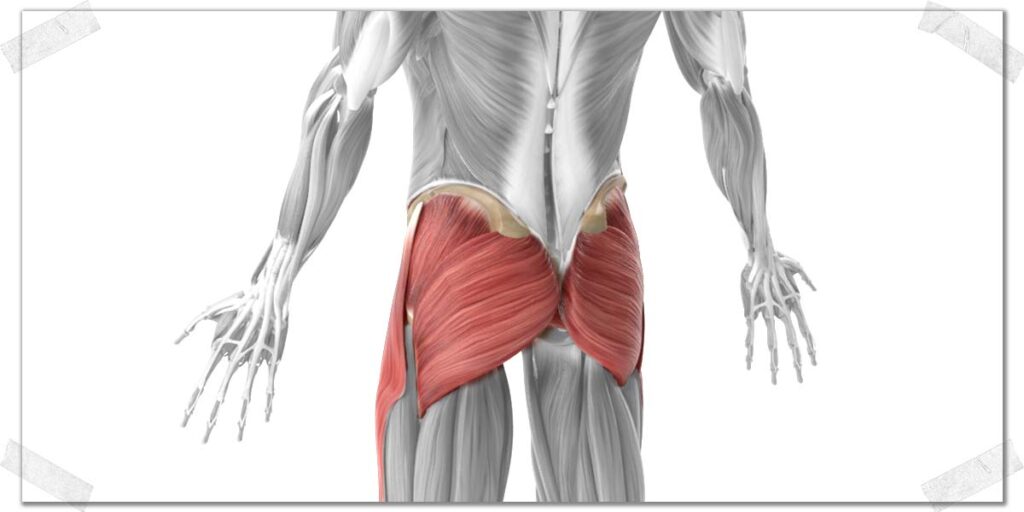
Any time I have a patient come into the clinic with a more extensive knee injury, one of the questions I’ll ask early on during the subjective interview is, “how is your hip feeling?” This will often bring a response along the lines of “now that you mention it, it hasn’t been feeling very good.”
Anytime the knee has undergone an injury that has affected its function (such as its range of motion, ability to bear weight, etc.), the same leg’s hip function will be affected.
The more extensive the knee injury and the longer the injury has been present, the more significantly the hip can be impacted.
The most common issues that affect the hip in these circumstances are:
- Reduced mobility
- Sensations of tightness
- Reduced muscular strength
As such, ensuring you focus on maintaining or improving your hip’s strength, endurance, and mobility should be a top priority as you simultaneously work on regaining your knee strength and function.
Poor hip health will often lead to decreased knee function. Don’t dismiss the importance of maintaining or improving your hip health when it comes to keeping your knee strong and healthy.
Pro tip: the added bonus of working on your hip is that it can provide your workouts and exercise sessions with a bit more variety and extra goals to work towards.
Considerations for improving hip health
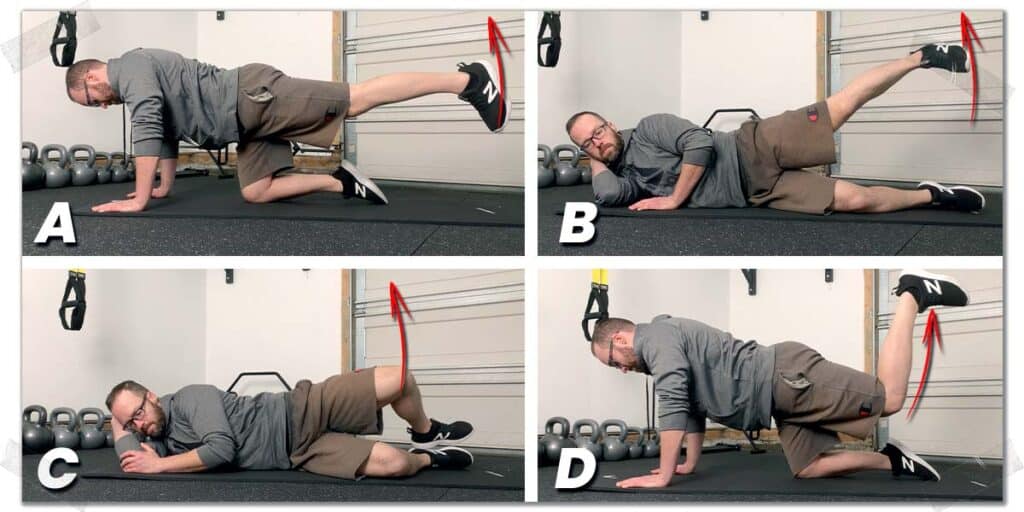
Note that the affected/injured knee would be the one that is not resting on the ground (for all of these exercises).
A few unique considerations come into play when keeping your hip strong and healthy during or after an injury.
For starters, strengthening and mobilizing your hip may be tough to do if your knee is still weak or sore (if you can’t put a lot of weight on your knee, it’s very tough to load up your hip).
Thankfully, the option to use open-chain exercises works exceptionally well in this situation. An open chain exercise refers to a movement where the foot is not in contact with the floor or any other platform during an exercise.
These open-chain movements allow the hip muscles to be challenged with higher resistance levels while keeping the knee offloaded the entire time (since no weight-bearing force is running through the knee).
Examples of some open-chain hip exercises you can try include:
- Clamshells
- Seated internal rotations (my absolute favorite)
- Sidelying hip abductions
- Bent-knee kickbacks
- Quadruped straight leg raises
A quick Google or YouTube search using these exercise names will walk you through all you need to know to perform them correctly.
Just be aware that depending on the type, extent, and current phase of your knee injury rehabilitation, you might experience knee discomfort or pain. If you experience high levels of discomfort or any type of pain, you may want to hold off on any of those exercises for the time being.
Strategy 4: Dial in optimal loading for your leg and knee exercises
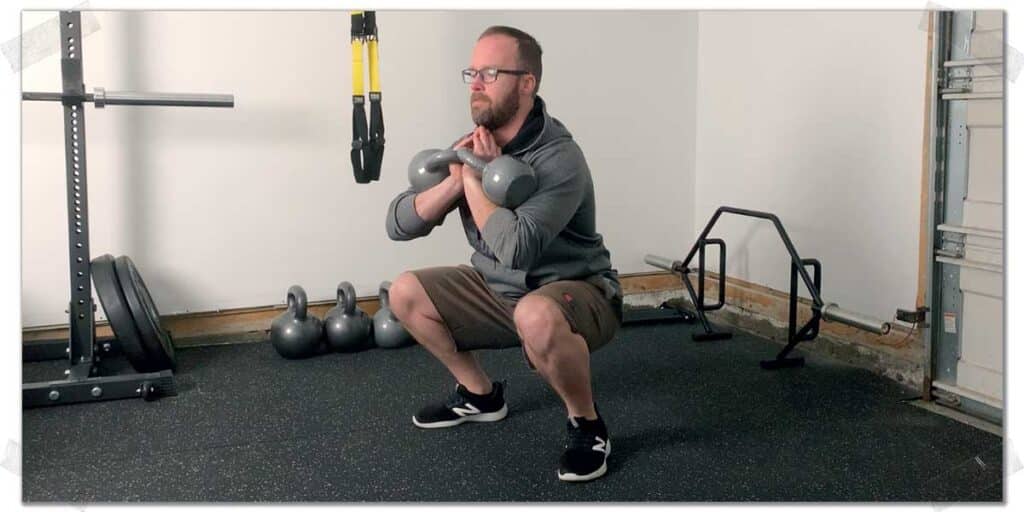
Optimal loading is everything when it comes to working out after a knee injury; it’s the cornerstone to help you regain strength, endurance, and even mobility during and after your knee rehabilitation.
Seriously, you must dial it in as much as possible. Doing so will keep your knee safe and optimize the rate that your knee (and the rest of your lower body) becomes stronger and healthier.
So, what is loading?
Loading refers to the process of exerting a body part against a predetermined resistance when exercising. As you’re likely aware, resistance exercises are an essential part of injury recovery.
When it comes to exercising your knee after an injury, using an ideal resistance will act as a signaling mechanism to the knee joint and the muscles crossing the knee, which tells these tissues to become stronger and healthier. The key is to dial in the right amount of this resistance.
Using too little resistance with your exercises won’t provide adequate simulation, however, using excessive amounts will likely only lead to unnecessary pain and setbacks.
In other words: you can’t afford to use too little or too much. So how do you dial in the right amount? Read the next session to get the answer!
How to use optimal loading strategies when working out
There could be an entire book written on this topic, but neither you nor I have the time for that. So, I’ll give you the general points that will serve as the foundation of what to know.
Here are the takeaways:
- Loading should never be painful – not in your knee or anywhere else in your body.
- The earlier your re-introduction to working out with your knee exercises and other exercises, the slower you should keep your movements. This helps ensure you don’t strain or over-exert any tissue that may compromise its health.
Essentially, this is all about performing resistance training exercises with a calibrated load. It can take time and effort to dial in the amount that’s best for your knee, so be patient and don’t think you have to figure it all out on day one.
How many sets and repetitions for an exercise?
Higher repetition ranges with an overall low load are likely your best bet when in the early phases of getting back into the gym. Ranges around ten to fifteen will likely get you in the ballpark for challenging components of your knee’s strength and endurance. Keep in mind, however, this is just a general guideline.
The last two repetitions of your knee exercise should feel somewhat challenging but still doable with strict form. If you don’t feel any fatigue by the end of your last repetition, you may want to increase either your repetition range or your overall load.
If your form or technique breaks down at any point, decrease the repetitions or load so that you can complete the entire exercise without compromising on your overall execution.
Again, as a general rule, 2-4 sets for a given exercise should suffice. It may be best to start with two sets for the first week or so, then add an additional set as your strength, endurance, and confidence all increase.
The same can be said for how many knee-dominant exercises you perform; it may be best to start with one or two exercises, then add additional exercises as time goes on (as your knee strength, endurance, and overall confidence all improve).
Strategy 5: Incorporate multi-plane movement for your knee
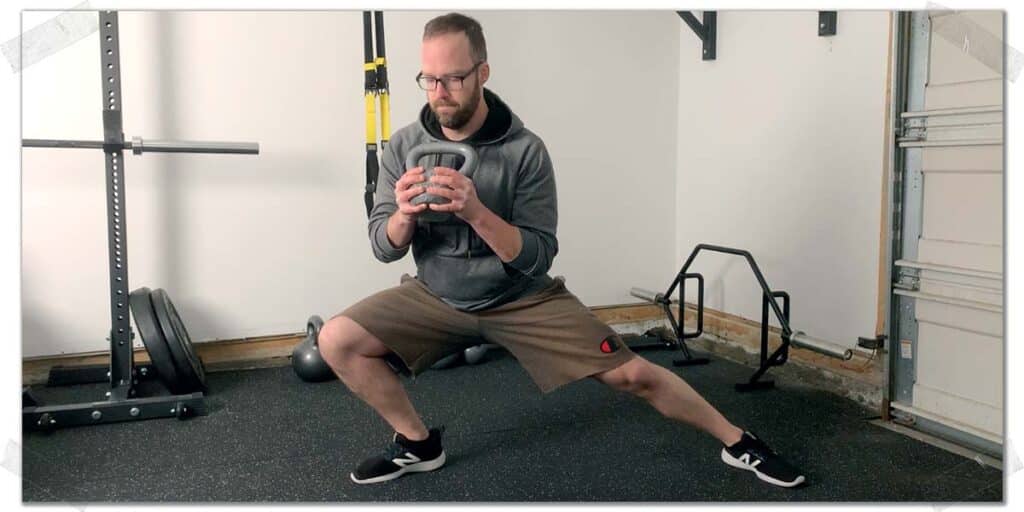
When it comes to strengthening your knee, priority number one should always be regaining strength and stability in the sagittal plane – that is, regaining strength and stability when bending and straightening your knee joint (also known as flexion and extension, respectively).
This plane of movement requires the most functional movement for our daily lives (walking, using stairs, getting up from a chair, etc.).
But there needs to be more than this sagittal strength and stability alone; the knee must also have the strength and stability required to resist unwanted forces that can stress the joint in different directions.
If your knee doesn’t have the capacity to resist these forces, it can lead to instability of the joint, which can lead to injury or setbacks as you work on your recovery.
There is an entire world of how one could incorporate multi-plane movement into their knee rehabilitation journey, which I can’t unpack within a single article.
Nonetheless, the following section will cover some weightlifting exercises and general movements you can consider incorporating into your exercise regimen as you work to regain strength and endurance in your knee.
Exercises and movements to consider for knees and legs

For starters, my absolute favourite piece of gym-based fitness and exercise equipment for knee rehabilitation is the TRX suspension trainer. If you’re not sure why, it may help to check out my article:
That article will be a goldmine for helping you understand how the TRX can appropriately challenge your knee strength, stability, and mobility as you get back into the gym. Within the article, you’ll learn how exercises like curtesy squats, split squats, and side lunges can be precisely tuned to your needs and abilities.
Pro tip: TRXs are quite common these days, and as such, you’ll likely find them in most commercial gyms. They’re also an outstanding (and highly practical) piece of home-exercise equipment.
Now, if a TRX isn’t an option for you, there are still plenty of movement options to consider.
There’s no need to get overly complicated here; keeping it slow and simple (especially in your early days of returning to working out) is your best bet.
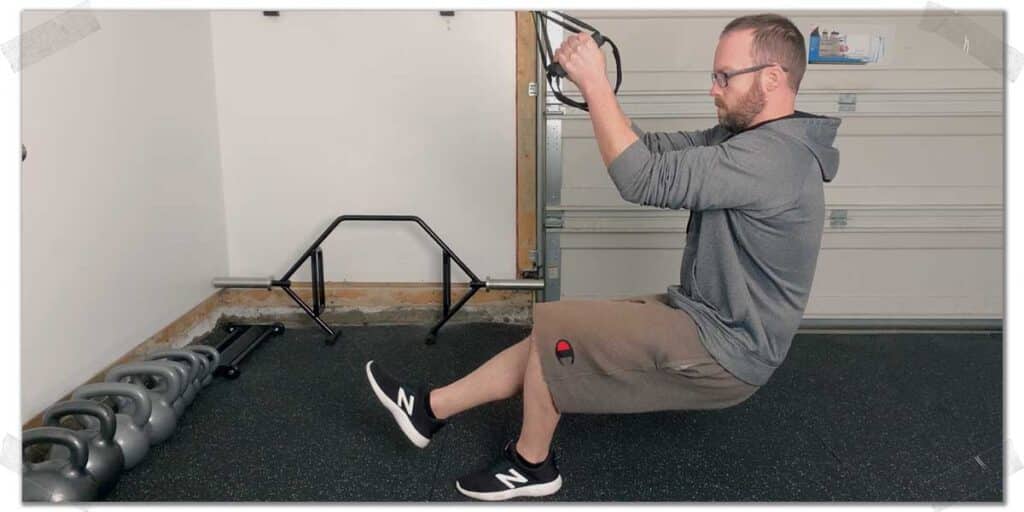
Simple movements such as the following are rudimentary exercises that challenge transverse stability in the knee:
- Side step-ups onto a platform
- Diagonal lunges
- Side-stepping through an agility ladder
Again, a quick google or YouTube search of any of these exercises should yield some helpful videos that can guide you along with any of these movements. Just remember that you may have to modify them to suit the needs and abilities of your knee.
Strategy 6: Progress your knee’s range of motion
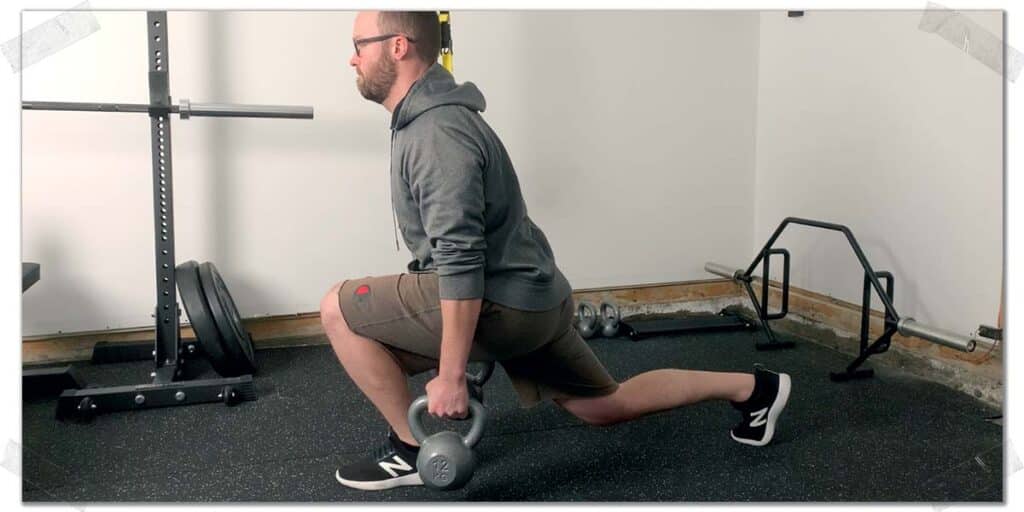
As your injury recovery progresses, so should your range of motion for any exercises you perform.
Regaining range of motion to an injured body part (such as your knee) should always be a top priority and be accomplished as quickly as possible.
The reason being: the longer the absence of a full range of motion, the more challenging it can be to get that range back. Strength comes back relatively quickly, so don’t make strength the top priority until your range of motion in your knee has returned to normal.
Now, with that being said, if you’re still working to get your knee back to full health, it’s ok (and often expected) to use exercises within your workouts to facilitate recovery of your full range of motion. You’ll likely start with a smaller range but should strive to continually increase that range as time goes on.
Here’s how to do it:
- For any knee or leg exercise you perform, start by staying within a range you are physically and mentally comfortable within. Don’t push through pain.
- Use the largest range you can by going up to (but not through) the point of the movement where you feel pain or a loss of confidence.
- As time goes on, challenge yourself to push a little bit further into the range – as if you’re “testing the waters” to see what your knee’s response is. If it’s painful, stay with the current range. If it’s not painful, move further into the movement.
Regaining full range of motion in your knee (if you haven’t already done so) can take some time and effort, but getting this range back is imperative.
Strategy 7: Use a dynamic surface for added knee stability
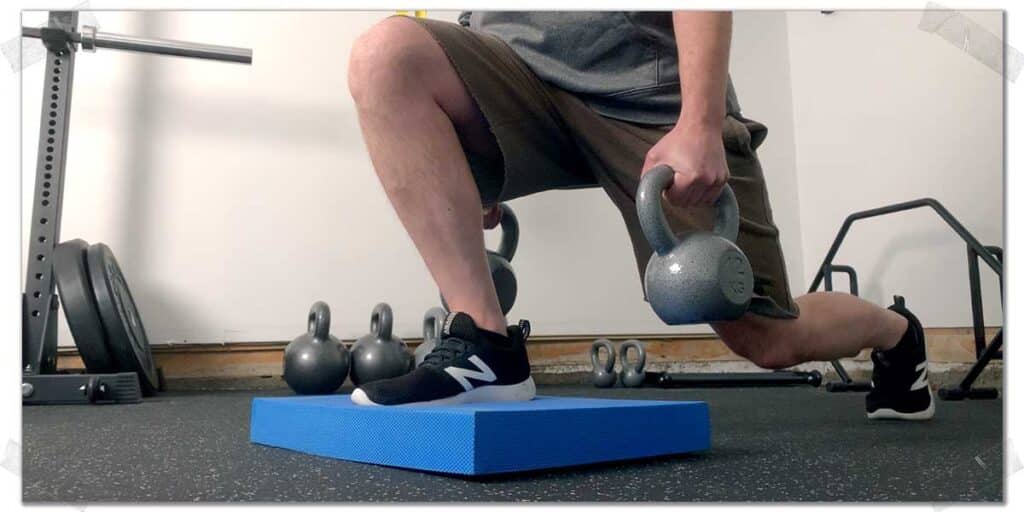
If you’re confident using your knee with general exercises and movements, you can consider adding a dynamic surface beneath your foot (or both feet) with specific exercises. This can be an outstanding way to further challenge the stability and control of your knee.
My favorite way to do this (with my patients and for myself) is to use a soft balance pad, such as an Air-X pad or a generic version (I use a generic brand I got off of Amazon).
These pads are a powerful rehabilitative piece of equipment for improving ankle, knee, and hip stability since the soft surface forces muscles in the leg (such as those crossing the knee joint) to work harder to resist unwanted movements (often called perturbations).
Pro tip: You don’t have to use one of these pads; you can stand on an old pillow, roll up a bath towel, or use any other soft object that achieves the same effect.
Lunging onto one of these pads or performing lunges while keeping your foot on the pad at all times are deceptively challenging. There are plenty of other exercises you could try as well. The key is to always use slow movement and keep it controlled at all times.
Related article: Fixing Knee Pain from Pistol Squats: Everything You NEED to Know
Strategy 8: Progress the speed of movement
As you gain confidence with slower knee movements and lower body exercises, increasing the speed of your exercises can be the next step to take when it comes to regaining full confidence (and function) of your knee.
Progressing your exercise speed, however, should only be done in later to end-stage rehabilitation, and it should go without saying that it needs to be pain-free.
Simple examples of what this can look like include:
- Progressing from a slower lunge to one that’s quicker
- Progressing from slower bike pedaling to quicker bike pedaling
- Rising out of a squat at a quicker rate of speed
- Progressing from slow-pace jogging to a more moderate pace
It can take a bit of experimentation to determine which speeds might be ideal for your needs and abilities and for which exercises this may be most appropriate. Still, as time goes on, you may well feel the physical and psychological (i.e., added confidence) improvements if you’re willing to progress the speed of your movements (but make sure it’s appropriate for you to do so).
Strategy 9: Modify your knee recovery as needed
Regaining physical strength and confidence after a knee injury (or any other type of injury, for that matter) should always be an individualized pursuit since no two people are alike.
As such, there will be plenty of room for modifying any of these workout concepts to better suit your needs. The best approach is one that is tailored to your needs and abilities. Knowing how (and when) to do this can be challenging for plenty of individuals, so don’t be afraid to reach out for help if needed.
For additional guidance, you may want to consider working with any (or all) of the following specialists:
- An orthopedic physical therapist (a physical therapist specializing in muscles, tendons and joints).
- A certified personal trainer or strength and conditioning specialist.
- An exercise physiologist or kinesiologist (individuals specializing in the human body’s response to exercise and physical performance).
Working with others isn’t always a feasible option, but it can be extraordinarily helpful, even if only for one or two sessions. So, if you have the means to work with a qualified specialist, definitely consider doing so!
Final thoughts
It can be an unsettling or confusing experience to begin working out after a knee injury. While every individual’s circumstances will be different for where they should start (and what they should and shouldn’t do along the way), the general principles outlined in this article can serve as an effective starting point for getting you pointed in the right direction.
As always, getting a qualified healthcare specialist to assist you with your path to full recovery is your best bet since it ensures the safest and most optimal path back to regular workouts and physical activities with your knee.
Frequently asked questions
I’ve included some brief answers to some commonly asked questions regarding how to workout after a knee injury. Feel free to read the questions and answers below if you want more insight!

Hi! I’m Jim Wittstrom, PT, DPT, CSCS, Pn1.
I am a physical therapist who is passionate about all things pertaining to strength & conditioning, human movement, injury prevention and rehabilitation. I created StrengthResurgence.com in order to help others become stronger and healthier. I also love helping aspiring students and therapists fulfill their dreams of becoming successful in school and within their clinical PT practice. Thanks for checking out my site!

